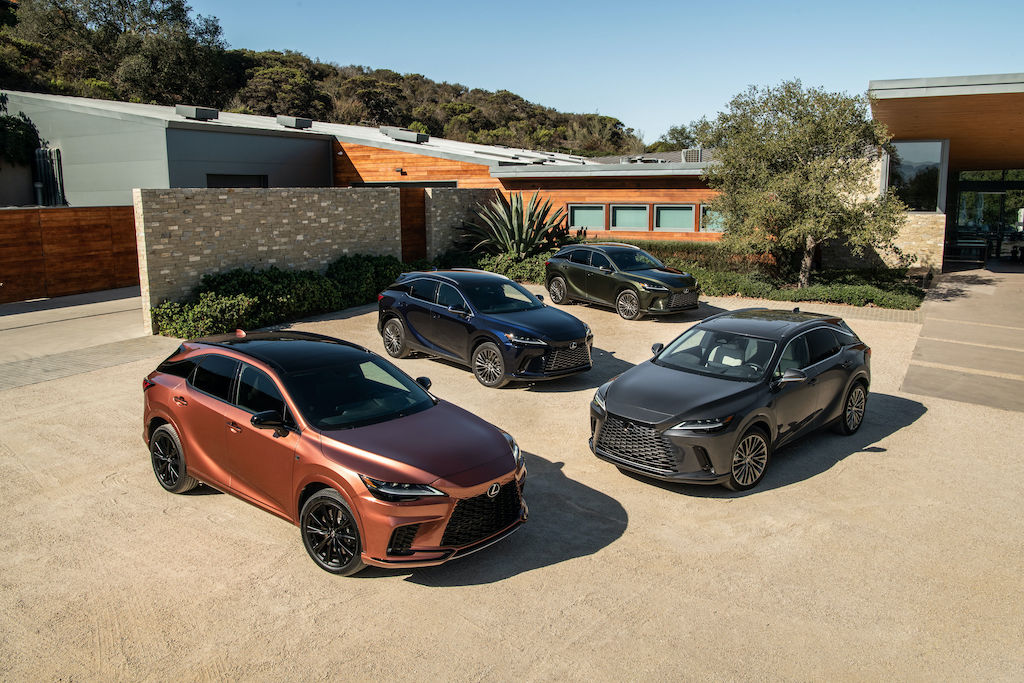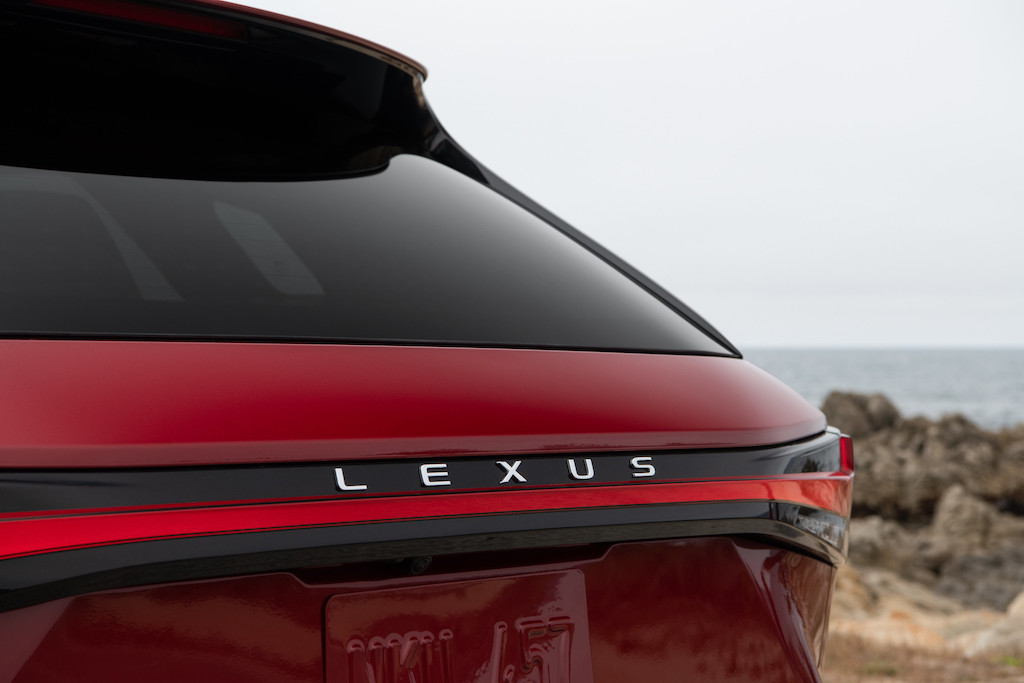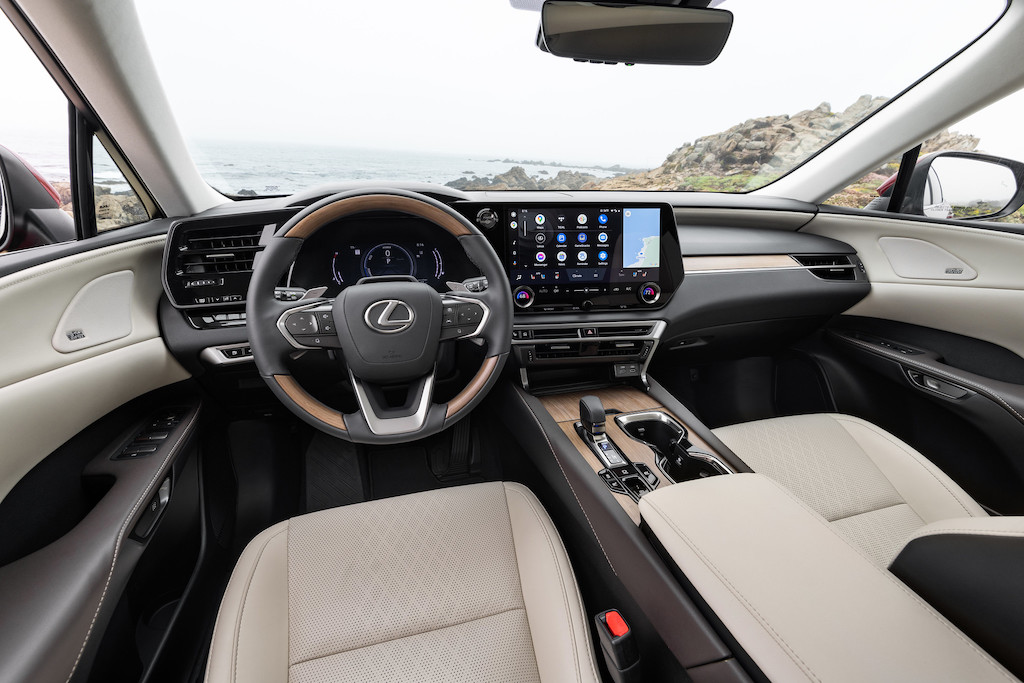2023 Lexus RX 350h review: True to the classic Lexus experience

SANTA BARBARA - There's an all-new Lexus RX, slated for launch here at the Singapore Motorshow 2023, and if you're wondering which version will be hybrid, the easy answer is: All of them.
Lexus launched the new RX to the press this month with four powertrain options, but just three are making it to Singapore. The one that isn't? The RX 350, a 2.4-litre turbo petrol model.

That leaves an all petrol-electric hybrid lineup for Singapore, as part of authorised dealer Borneo Motors' plan to have a fully electrified range of Lexus here by 2025. Lexus itself is going all-electric and has set itself a target of 2035 to leave combustion power behind.
Till we get there, self-charging hybrids and plug-ins are the way to go for Lexus (none of that mild hybrid stuff for this brand). That means a fascinating lineup.
Kicking things off and likely to be the bread-and-butter car of the new RX range is the RX 350h, reviewed here.

Then there's a plug-in RX 450h+ (pictured above). With an 18.1kWh lithium-ion pack, it should do enough distance on pure electric power on each charge to cover a typical day's motoring in Singapore - call it 50km in our traffic conditions. There's a 2.5-litre engine for long distances, making those golf trips to Malacca headache-free.
If you want to get to the greens faster, there's the RX 500h (below) - or RX 500h F Sport Performance Direct4, to give it its full name. That one has 367 horsepower, a bunch of chassis tweaks and the first hybrid setup from Lexus that pairs a turbo engine with electric motors.

Something for everyone there, and we drove pre-production examples of the RX to get some early impressions. Let's kick things off with the volume version.
No doubt about it, the new RX is a striking car. Come to think of it, the last one was, too. Its huge spindle grille and the floating roof effect created by the blacked-out D-pillar made it stand out.
Both have evolved. The floating roof idea is still in place, though now it curves down more elegantly toward the rear, which swoops up a bit to meet it.

As for the spindle grille, it's still there, but it's now half open and half solid. Where the two portions blend together is where you find the Lexus badge, symbolising the brand's transition to electric power. It's a neat idea, anyway.
With grilles set to go the way of the Dodo, Lexus says it's focusing now on making its cars spindle-shaped. The curves at the RX's rear give you some idea of what that means.
If one thing about the new car's caboose really catches the eyes though, it'll be the way the taillights stretch across it, linked by an elegant light bar.

This fifth-generation RX is apparently completely new, including the lug nuts. I guess it's a coincidence that it's the same length as the last one, at 4,890mm. It's also a bit wider (by 25mm) at 1,902mm but 10mm less tall, standing 1,695mm.
The wheelbase is 60mm longer, at 2,850mm, and the front and rear tracks have been widened by 15mm and 45mm respectively. Wheel sizes are 19 and 21 inches, with the latter filling the arches nicely.
The new RX sits on Toyota's GA-K platform, which underpins a wide variety of cars (including the Toyotas Camry and Harrier, and the Lexus ES as well as the NX), but it has a particular rear portion that accommodates a multi-link rear suspension setup and a new e-axle for the RX 500h.
It's been glued and welded with special processes and uses lots of high-strength steels, so it's stiffer and stronger, but the whole thing weighs roughly 90 kg less than before. So the RX is no longer than before, but wider and stiffer… See if you can guess where this is going.
It's like someone waved a magic wand in the cabin, because the RX is completely different from before. The laser cut wood veneers, metallic knobs and general olde worlde approach to luxury are out, replaced by a more contemporary interior.
The dashboard borrows heavily from the current NX (a smaller SUV), so there's the same 14-inch touchscreen with the same menu system.

There are still physical buttons, but the controls all lean digital and are fairly easy to figure out. It's certainly way better than the awkward touchpad and cursor arrangement in the last car.
It has the 64-colour LED ambient lighting system from the NX, along with the electric door latch system - try to open a door into an approaching cyclist's face and the Lexus will keep you locked in and save you the lawsuit.

Interestingly the transmission control is now like the one in the Prius, and its neat, stubby form sits ahead of buttons for the drivetrain - press EV Mode to force the Lexus to roll around electrically, for instance.
Oddly enough, there's no longer a drive mode selector switch. If you want Eco mode you'll have to tap the touchscreen or use the steering wheel controls, now have little touch-sensitive pads (again, seen in the current NX). Like with anything, getting used to them will take time even if you've had a Lexus before (or maybe especially if you've had one).

Borneo will sell the RX 350h in both basic Executive and plusher Luxury trim lines, but we have precious little detail about local spec. Some features worth having are the Apple CarPlay and Android Auto connectivity, along with the wireless charging pad so you won't need the USB-C ports.
Another feature listed as an option in the press material but hopefully standard in Singapore: ventilated seats. This time you can have them in the back, too.
Let's start with the back. First up, there's no more seven-seat RX L and there ain't going to be one. Apparently such a car doesn't really fit in with Lexus' idea of what it wants the RX to be.
Fair enough. It's still quite a large Sport Utility Vehicle (SUV) and it is properly roomy in the back. Legroom is up slightly (12mm), but that's more to do with how the seats are mounted in the car, plus the use of thinner front seats. If you're wondering where the 60mm stretch to the wheelbase went, that was apparently meant to make the RX drive better.

Lexus says the boot is spacious enough for four golf bags, and like before, folding the rear seatbacks to expand the cargo area is something you can do with a button, rather than muscle power.
There's no quoted figure for size, but given that the smaller NX already has 520 litres of luggage capacity, Lexus will likely put out a similarly impressive number for the RX. For what it's worth, the boot floor is 50mm longer, as well as 30mm lower to make loading easier.

No complaints about room in the front of the cabin. The RX doesn't feel like a giant car (the way, say, a Hyundai Staria does) but it's roomy all 'round and the seats feel supportive and comfortable.
Even in pre-production form, the RX 350h sits pretty comfortably at 100mph (or just over 160km/h), though I'd rather not say how I know. Wind noise is nicely suppressed up to that speed, and whether the tyres rumble depends on what kind of highway surface you're on.

The petrol engine does drone away pretty intrusively if you're hard on the right pedal, making acceleration feel like an effort, but if you're rolling around at Singapore speeds you'll find it a quiet car.
It's a smooth one too, in terms of picking up speed and just how the engine and the motors do their work. When petrol power comes into play, it does so seamlessly, and the brakes don't feel grabby or spongy, like they do in some cars that use regenerative braking.
Lexus says it worked like crazy on the RX's handling, and the payoff is pretty clear. Though it's a large car, it feels responsive at the steering wheel and slips through corners with a sense of precision. The RX 350h feels like the most softly-sprung version of the three models we'll be getting, but though it doesn't feel super grippy, it also doesn't feel sloppy when chucked into bends.

All that work on the chassis - stiffening it, redesigning the suspension, widening the tracks, lengthening the wheelbase and so on - has created a large SUV that's easy to handle and faithful in its responses. In the RX 350h those characteristics actually seem to soothe instead of excite.
Lexus considers the RX a competitor to SUVs like Audi Q7, BMW X5 and Mercedes GLE. It's actually slightly smaller than them (plus they have seven-seat configurations), so if there's a rivalry, it's an indirect one.
Besides, the RX 350h seems to offer something different: you can drive a hulking German SUV, or waft around in something more sculptural in form that's also efficient, refined and agile.

Then there's the pricing. Not to get ahead of ourselves, but we reckon the RX 350h could start at around $350,000 for a more basic Executive version.
If so, that's a good hundred grand cheaper than, say, the X5. Things would quickly cross $400,000 with the RX 450h+, but the plug-in space is pretty uncrowded there. Perhaps the racy RX 500h will be the one that takes the fight straight into German territory.
Lexus likes to say it invented the luxury SUV in 1997 with the first RX (Land Rover would likely have something to say about that), and it's certainly reinvented the car itself since then. This fifth generation is sharper looking, sharper to drive and much more modern inside.
As it turns out, the first hybrid Lexus was an RX, and it seems fitting that petrol-electric tech features so heavily in this one, with three different approaches to using it between the RX 350h, the plug-in RX 450h+ and the high performance RX 500h. The entry-level model does feel true to the classic Lexus experience, though.